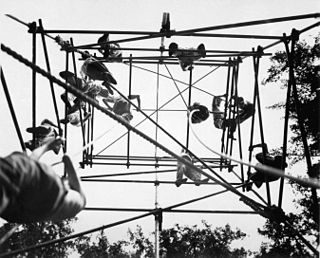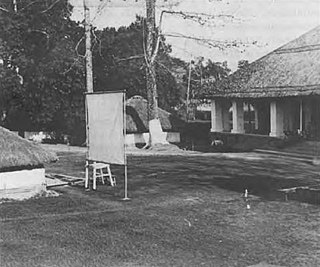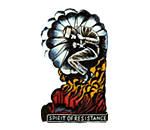
The Office of Strategic Services (OSS) was an intelligence agency of the United States during World War II. The OSS was formed as an agency of the Joint Chiefs of Staff (JCS) to coordinate espionage activities behind enemy lines for all branches of the United States Armed Forces. Other OSS functions included the use of propaganda, subversion, and post-war planning.

Operation Jedburgh was a clandestine operation during World War II in which three-man teams of operatives of the British Special Operations Executive (SOE), the U.S. Office of Strategic Services (OSS), the Free French Bureau central de renseignements et d'action and the Dutch and Belgian armies in exile were dropped by parachute into occupied France, the Netherlands and Belgium. The objective of the Jedburgh teams was to assist allied forces who invaded France on 6 June 1944 with sabotage and guerrilla warfare, and leading local resistance forces in actions against the Germans.

Detachment 101 of the Office of Strategic Services operated in the China-Burma-India Theater of World War II. On 17 January 1956, it was awarded a Presidential Distinguished Unit Citation by President Dwight Eisenhower, who wrote: "The courage and fighting spirit displayed by its officers and men in offensive action against overwhelming enemy strength reflect the highest tradition of the armed forces of the United States."

David Kirkpatrick Este Bruce was an American diplomat, intelligence officer and politician. He served as ambassador to France, the Federal Republic of Germany, and the United Kingdom, the only American to be all three.
The Central Intelligence Group (CIG) was the direct successor to the Office of Strategic Services (OSS), and the direct predecessor to the Central Intelligence Agency. The official duties of CIG are quoted by Assistant Executive Director Shields:
The Central Intelligence Group is a recently created interdepartmental organization in which the State, War, Navy, and sometimes other departments participate. It coordinates all activities of the Government involved in obtaining and analyzing information about foreign countries which this country needs for its national security. It also furnishes interdepartmental analyses of this type of information or use by Government officials.
National governments deal in both intelligence and military special operations functions that either should be completely secret, or simply cannot be linked to the sponsor. It is a continuing and unsolved question for governments whether clandestine intelligence collection and covert action should be under the same agency. The arguments for doing so include having centralized functions for monitoring covert action and clandestine HUMINT and making sure they do not conflict, as well as avoiding duplication in common services such as cover identity support, counterespionage, and secret communications. The arguments against doing so suggest that the management of the two activities takes a quite different mindset and skills, in part because clandestine collection almost always is on a slower timeline than covert action.

The Special Forces Club (SFC) is a private members' club located at 8 Herbert Crescent in Knightsbridge, London. Initially established in 1945 for former personnel of the Special Operations Executive, members of wartime resistance organisations, the Special Air Service, Special Boat Service and First Aid Nursing Yeomanry, its membership now includes those who had served, or were serving, in organisations and units closely associated with special operations and the intelligence community.

The Secret Intelligence Branch of the United States' Office of Strategic Services was a wartime foreign intelligence service responsible for the collection of human intelligence from a network of field stations in Asia, Europe, and the Middle East.

Morale Operations was a branch of the Office of Strategic Services during World War II. It utilized psychological warfare, particularly propaganda, to produce specific psychological reactions in both the general population and military forces of the Axis powers in support of larger Allied political and military objectives.
The head of the Office of Strategic Services (OSS), William Donovan, created the X-2 Counter Espionage Branch in 1943 to provide liaison with and assist the British in its exploitation of the Ultra program's intelligence during World War II. A few months before, Donovan had established a Counterintelligence Division within the Secret Intelligence Branch of the OSS but rescinded this order upon development of the X-2. The X-2 was led by James Murphy, whose branch would have the power to veto operations of the Special Operations and Secret Intelligence Branches without explanation. Donovan modeled the Counter Espionage Branch on British Counter Espionage. With the creation of the X-2 Branch, the British insisted that it follow British security procedures to maintain the secrecy of Ultra. The X-2 established separate lines of communication for itself as a self-contained unit. By the end of World War II, the X-2 had discovered around 3,000 Axis agents.

Operations Ginny I and II were two ill-fated sabotage missions conducted by the U.S. Office of Strategic Services (OSS) in 1944 during the Italian campaign of World War II. Their aim was to blow up railway tunnels that would cut the line of communication to German forces in central Italy. The first mission, Ginny I, occurred on February 27/28, 1944, when fifteen U.S. soldiers attempted to land west of the small town of Framura. However, the OSS team had to abort after they landed on the wrong spot and could not find the tunnel. The second attempt, Ginny II, occurred a month later on March 22 when the same team attempted to land on the same spot. However, they landed again in the wrong place and were captured two days later by the German Army. Although the OSS members were properly uniformed, they were summarily executed on March 26 under Hitler's Commando Order of 1942 at the command of German General Anton Dostler. After the war, Dostler was tried by a military tribunal for the deaths of fifteen Americans, sentenced to death, and executed by a firing squad.

The Research and Analysis Branch(R&A) was a branch of the Office of Strategic Services (OSS). Established in the OCOI with the appointment of James Phinney Baxter III as the first Director of Research and Analysis, July 31, 1941, the branch became operational within the Office of the Coordinator of Information on August 27, 1941. With OSS General Order 1 on October 17, 1942, R&A was absorbed into the new structure of the OSS. On January 4, 1943, with the restructuring of the OSS in OSS General Order 9, R&A was placed under the leadership of the Deputy Director of the Intelligence Service.
George James Doundoulakis was a Greek American physicist and soldier who worked under British Intelligence during World War II with SOE agent Patrick Leigh Fermor, and then served with the OSS in Thessaly, Greece.

The Maritime Unit (MU) was a branch of the Office of Strategic Services that enabled maritime warfare for the allies during World War II. MU's mission was to "infiltrate agents and supply resistance groups by sea, conduct maritime sabotage, and to develop specialized maritime surface and subsurface equipment and devices." MU developed specialized boats, equipment, and explosives, fashioned underwater breathing gear, waterproof watches and compasses, an inflatable motorized surfboard, and "a two-man kayak that proved so promising that 275 were ordered by the British."

Formerly known as the Veterans of the OSS, the OSS Society is the association of veterans of the Office of Strategic Services, dedicated to preserving the legacy of the famed intelligence agency.

Operational Group Command (OG), was a branch of the Office of Strategic Services during World War II that specialized in guerrilla warfare and independent operations against designated Axis targets. The original A Teams of US Army Special Forces, Operational Detachments Alpha (ODA), are modeled after the successes of Operational Group Command and its groups.

Millard Preston Goodfellow, who often went by the name "Preston Goodfellow," was an American soldier, spy, diplomat, journalist, war correspondent, and newspaper publisher. A veteran of World War I, Goodfellow became a leading figure at the Office of the Coordinator of Information and the Office of Strategic Services during World War II.

Robert A. Solberg (Solborg) was a soldier and spy during World War I and World War II, becoming a key figure in the development of the Office of the Coordinator of Information and the Office of Strategic Services, precursor to the Central Intelligence Agency.

Garland H. Williams (1903–1993) was an American pioneer of covert investigations, military counterintelligence, white collar investigations, espionage, training and planning, and a lifelong law enforcement officer. He is a veteran of World War II and the Korean War. During World War II, Williams was integral in the training of thousands of American hopeful would-be undercover operatives and guerrilla fighters in both the Military Intelligence Division and the Office of Strategic Services.

Richard Melville "Bill" Brooker was a British soldier, spy, instructor, and commando during World War II, and integral to the Allied effort in defeating the Axis. He was a member of Churchill's Special Operations Executive (SOE), and Commandant of Camp X, where he trained the men and women who would become the leaders of the Office of the Coordinator of Information (COI), which became the Office of Strategic Services (OSS), a precursor to the Central Intelligence Agency (CIA). He is considered one of the fathers of modern American central intelligence, and gained the admiration of William J. Donovan and Allen Dulles, and even is mentioned as being a great instructor of spies in the memoirs of Kim Philby.











